In a nutshell:
- While the effects were muted, last Tuesday’s election outcomes do not reflect vote totals.
- Using three electoral statistical tests highlighted in our June report, we find that the November 6 general election outcomes suggest gerrymandered districts.
- With the passage of Proposal 2, beginning with the new maps drawn for 2022 elections, there will be more data to determine how much of the problem is gerrymandering and how much is other explainable factors.
While Michigan voters approved Proposal 2, which is aimed at curtailing gerrymandering following the next decennial census in 2020, Michigan chose congressional and state legislative representatives at the November 2018 general election using the district maps drawn following the 2010 census. Several claims have been made arguing the current maps are not fair and the result of gerrymandering.
Despite the claims, Democrats picked up more seats in the state’s Congressional delegation, the state House, and the Michigan Senate than they had at any other point under the current district maps. Does this refute the claims of partisan gerrymandering? Using preliminary data from the election results, we applied the three statistical tests we used in Quantifying the Level of Gerrymandering in Michigan to see if there are still signs of partisan-influenced maps (Note: we won’t be covering the methodology behind the tests here; read Quantifying the Level of Gerrymandering in Michigan to learn more about them).
Congressional Districts
Under Michigan’s current congressional map, the state’s delegation has consistently been 9 Republicans and 5 Democrats. This changed during the 2018 election, as Democrats won their largest share of the two-party vote this decade and in the process flipped the 8th and 11th congressional districts. While this result diverges with previous trends, Democrats won nearly 8 percent more of the popular vote than Republicans, yet the seat distribution ended in an even 7-7 split (Charts 1 and 2). So is there still evidence of gerrymandering among Michigan’s congressional districts?
Charts 1 and 2
2018 Congressional Vote and Seat Shares
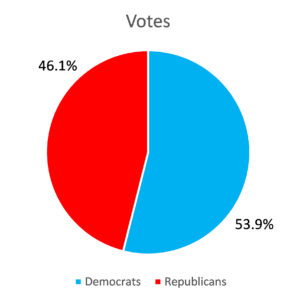
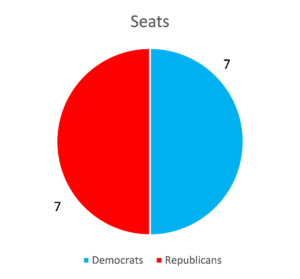
Each of the three tests interpret the congressional districts as gerrymandered, though each also saw scores closer to non-gerrymandered results compared to the results from the 2016 election. The efficiency gap, shown in Table 1, drops more than 5 points down to 9.2, yet is still higher than the 7 point threshold the test sets. This result should be taken with a grain of salt, as there are an even number of districts — the proportional outcome based on the results would be about a 7.5 to 6.5 split in favor of Democrats, which is obviously impossible, and given the small number of seats, a half-seat variance for each party creates a result that might potentially be larger than expected.
Table 1
The Efficiency Gap

*Note: The proposed threshold to indicate gerrymandering is any score of 7 points or higher
The mean-median test and t-test do not suffer from bias due to the small number of districts, as they do not rely on the number of districts a party won, and agree with the efficiency gap’s finding of gerrymandering. The mean-median test (Table 2) shows that Republican candidates are still advantaged by the way districts were formed, as Republicans outperformed their statewide average in a majority of districts by 5 points, while Democrats under-performed their statewide average by about 5 points. While this is a slight decline from 2016, it still indicates a relatively sizable advantage for Republicans.
Table 2
The Mean-Median Test

*Scores above 5 or below -5 indicate evidence of gerrymandering.
Similarly, the t-test shows evidence of gerrymandering. While the test fell above the .05 threshold (see Table 3), it is still in a category of “needs more analysis,” and under evaluations of the election there is some evidence that the districts won by Democrats and those won by Republicans differ greatly. Republicans, for example, did not win a district with more than 64 percent of the two-party vote share; in fact, 5 of 7 Republican seats were under 60 percent of the 2-party share, while the only 2 Democrat seats below that threshold were districts that changed control.
Table 3
The T-test

*Results of .050 or lower show statistically significant evidence of gerrymandering.
State House
While there are reasons to potentially downplay test results for Michigan’s congressional districts, the three gerrymandering tests show more evidence of gerrymandering in the state House of Representatives. Democrats won the statewide House vote by almost 190,000 votes, or a 5 percent margin. Despite that, as Charts 3 and 4 show, Republicans maintained a 58-52 advantage in the state’s lower chamber.
Charts 3 and 4
Michigan House Vote and Seat Shares
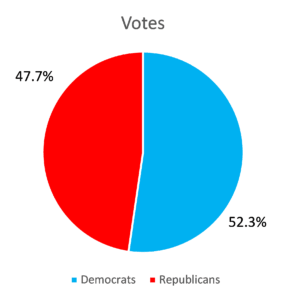
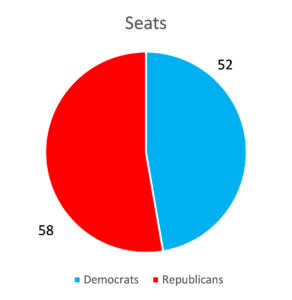
Each of the three tests correspond with the appearance of the results; the map was likely gerrymandered. The score for the efficiency gap remains roughly the same as 2016, as Democrats won a minority of seats despite winning a majority of votes.
For the mean-median test, results were close in line with the 2016 election, indicating that Democratic gains were not solely in already blue (or solely in red) districts. The t-test confirms this result, indicating that the districts each party won had very different results (with Democrats winning 70 percent of the two-party vote in 23 districts, compared to 2 Republican wins by that margin).
State Senate
The state Senate continues to show the largest disparity between votes and seats. Democratic candidates won a narrow majority of votes (with a margin of about 2.5 percent of the two party vote), but Republicans won 58 percent of the state’s districts (see Charts 5 and 6).
Chart 5 and 6
Michigan Senate Vote and Seat Share

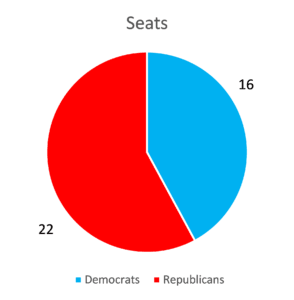
While the efficiency gap result is not nearly as extreme as 2014, a lot of the change in results here is because Democratic candidates picked up 6 seats. Because wasted votes in a district are highly dependent on the outcome, a few small swings can have a large impact on the final metric, causing the Michigan senate efficiency gap score to drop 10 points (though it still indicates a stronger gerrymander than either of the other two maps).
The mean-median test, which doesn’t account for outcomes of any given district, also shows a more extreme gerrymander than either of the congressional or state House maps (by a slim margin). The t-test indicates an extreme gerrymander as well.
What the future holds
Despite a significant increase in voting margin for Democrats in 2018, control of Michigan’s House and Senate did not change. Based on evidence from the four elections under the current districts, Michigan’s maps exhibit gerrymandering. While there is some merit to the idea that the high concentration of Democratic voters in cities is to blame, evidence has shown that it is likely not the sole cause for the disparity in Michigan’s electoral outcomes.
While the 2020 elections will use the same electoral maps one final time, the 2022 elections will provide a new approach to determining district boundaries. With the passage of Proposal 2, control over the map-making process will fall to a bipartisan commission. The maps the commision designs will provide a new insights to understand how strong effects like Michigan’s political geography were in creating biased outcomes observed in the current maps, and how much of the past electoral outcome was due to partisan gerrymandering.
